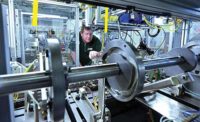Cell phones, tablets, GPS devices and other mobile electronics are smaller, thinner, lighter and more powerful than ever. Wireless Internet connections, RFID and Bluetooth have become essential features of these devices, necessitating highly complex transmission mechanisms.
To meet these performance requirements, ultra-miniature radio frequency (RF) cable assemblies are now common in mobile devices. These cable assemblies connect tiny antennas to the circuit board inside mobile electronic devices. The connectors for these cable assemblies must have a very low mating height, so as not to increase the thickness of the device. In addition, to permit serviceability, the connectors need to attach and detach easily from the board.
One of the smallest connectors currently in use has a mating height of only 1.2 millimeters! These tiny RF connectors are typically interfaced with a 36 AWG micro-coaxial cable with an outer diameter of 0.81 millimeter. Smaller connectors with even smaller micro-coaxial cables are already in development and will likely become the new standard soon.
Electronics assemblers find themselves faced with the challenge of processing these tiny wires and components with sufficient accuracy to maintain device reliability and sufficient speed to keep up with a growing market.
One of the major challenges for manufacturers working with ultra-miniature cable assemblies is overcoming human error and maintaining consistent precision. The tiny cables need be measured and cut to length within very tight tolerances. Then one or both ends of the micro-coaxial cable must be stripped with up to three processing steps (jacket, shield and center conductor). All of this needs to be accomplished in a high-production environment. Due to the small size of the cable, it has become practically impossible to achieve the required length tolerances with manual work or with semiautomatic tools.
Another challenge for manufacturers is quality control. In many cases, strip lengths and diameters must be viewed, measured and recorded to make sure they are within tolerances before terminating. With micro-coaxial cable, this would be extremely complicated and time consuming to accomplish manually. In addition, the use of microscopes or magnifying glasses is not only inefficient, but the quality of such measurements is subject to human error. Instead, a powerful camera with a 360 degree view that automatically measures and records the dimensional data is needed to not only guarantee quality, but ensure traceability of the data as well.
Achieving flexibility while maintaining speed also presents a challenge for manufacturers. The end of the micro-coaxial cable must be terminated using an automatic crimping press designed for the specific connector and cable combination being processed. Manufacturers need an automatic machine that can accommodate a wide range of cable sizes and connector types and also allow quick changeover between jobs. The automation platform must be flexible and have space to integrate additional processing steps, such as tinning, window stripping and stacking, because transporting the cables between individual processing steps can be problematic. Even the smallest touch to the cable end can bend it, rendering it unusable. In the worst case scenario, this can even result in failure of the end product. Therefore, it is important to have a fully automatic cable assembly system that incorporates all assembly and quality control steps.
As the need for smaller cable assemblies continues, speed, precision and quality control will be hot topics among manufacturers dealing with ultra-miniature RF cable assemblies. Manual hand tools are no longer sufficient for manufacturing mobile electronic devices, but a fully automatic machine can help overcome those challenges.
Machine Cuts, Strips andCrimps Coaxial Cable
The CoaxCenter 6000 is a fully automatic machine for processing micro-coaxial and coaxial cables, as well as single-conductor wires.
The machine has a unique, rotary stripping unit that precisely cuts and strips each cable layer. A centering device, consisting of six segments, ensures that the cable is kept in its optimum position during the incision without being damaged by the clamping pressure. Stripped parts are removed by a powerful extraction.
The machine’s rotary stripper can handle cables ranging from 40 AWG to 5.5 millimeters in diameter. Depending on the diameter and stiffness of the cable, the machine can cut cable lengths as long as 1,000 millimeters. (Longer cable lengths are possible with an optional active wire stacker.) Minimum cable length is 15 millimeters, excluding the stripped portion of the cable.
The machine can process both ends of the cable simultaneously. Maximum strip length on either side is 26 millimeters. Minimum strip length is 0.1 millimeter. Strip lengths are accurate to ±50 microns, depending on the cable type. The machine can process a variety of insulation, including Kapton, polyurethane, PVC, rubber, Teflon and Tefzel.
When programmed to produce a 100-millimeter long cable with a three-step stripping process on both ends, the machine can produce 1,200 pieces in an hour.
The CoaxCenter 6000 can be equipped with a variety of additional processing equipment, including a vision system, crimping press, tinning station, wire straightener, prefeeder and signal tower.
After cutting the cable, the machine holds the cable end with a single gripper for all subsequent processing. The cable is not transferred from one gripper to another. As a result, the cable retains its exact position and is fed to each station with maximum positional accuracy.
After all process steps have been carried out, the gripper sets the cable down without damaging the ends.
The vision system, QCam 360, automatically monitors stripping quality, eliminating the need for time-consuming manual measurements following production. Measurements are accurate to ±10 microns. The vision system can also be used to check the quality of the crimping process, such as determining if the terminal is seated correctly on the cable end. For traceability purposes, all production data, including 3D images of each cable, are recorded.








